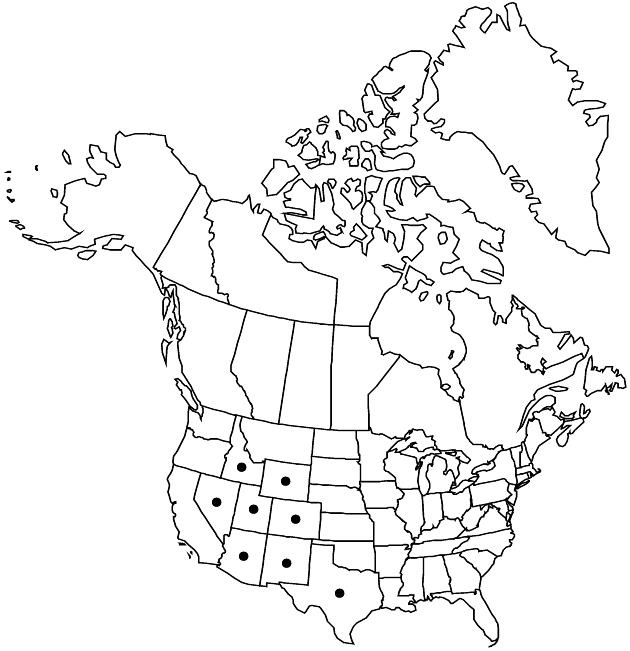Heterotheca fulcrata
Field & Lab. 19: 71. 1951.
Perennials, 17–50 (–80) cm; taprooted. Stems 1–30+, ascending to erect (sometimes reddish-brown), sparsely to densely hispido-strigose, sparsely to densely stipitate-glandular. Leaves: proximal cauline subpetiolate to sessile, blades oblanceolate, (13–) 22–46 (–60) × (3.5–) 5.3–10 (–14) mm, bases attenuate to somewhat rounded, margins entire, strigoso-ciliate (with a few longer hispid cilia near bases), apices mucronate, faces sparsely to densely strigoso-canescent, sparsely to moderately stipitate-glandular; distal sessile, blades ovate to lanceolate, 12–34 (–55) × 4–15 mm, little reduced to larger distally, margins entire to somewhat irregularly sinuate, sparsely to densely hispido-strigose (large cilia few to numerous, usually along much of margins, sometimes just proximally), faces sparsely to densely strigose, sparsely to densely stipitate-glandular (sometimes more glandular than more proximal blades). Heads (1–) 7–15 (–43), in open to compact, corymbiform arrays. Peduncles 1–20 mm, sparsely to densely strigoso-canescent, sparsely to moderately stipitate-glandular; bracts 1–4, proximal ovate to narrowly lanceolate (bases sometimes attenuate and winged short-subpetiolate), leaflike, distalmost often distinct from distal leaves, usually subtending or just proximal to and usually surpassing heads (obscure in narrow-leaved, hairy plants). Involucres cylindric to campanulate, 5.7–9 (–10.3) mm. Phyllaries in 4–5 series, lanceolate to linear-lanceolate, unequal (outer lengths 1/4–1/3 inner), scarious, faces sparsely to moderately strigose, sparsely stipitate-glandular. Ray-florets (5–) 11–21 (–34); laminae (7–) 9–13 (–16) × 1–2.7 mm. Disc-florets (12–) 26–66 (–110); corollas barely ampliate, 5–7.5 mm, glabrate, lobes 0.4–0.9 mm, sparsely hairy (hairs 0.05–0.2 (–0.3) mm). Cypselae monomorphic, obconic, compressed, 1.5–3 (–4) mm, ribs 10–12 (sometimes golden brown to brown), faces sparsely to moderately strigose; pappi off-white, outer of linear scales 0.25–1 mm, inner of 35–45 bristles (4.3–) 5–6.5 (–8) mm, longest acute to weakly clavate. 2n = 18, 36 (atypical plants).
Distribution

Ariz., Colo., Idaho, N.Mex., Nev., Tex., Utah, Wyo., n Mexico
Discussion
Varieties 4 (4 in the flora).
Heterotheca fulcrata is distinguished by the one to several, usually distinctive, ovate-lanceolate bracts subtending at least some heads of the arrays; the bases of the bracts are attenuate to sometimes winged-subpetiolate. In plants with large, ovate distal leaves, the bracts are sometimes hidden by the leaves. Rarely, such bracts are missing below most heads or only one is present, making identification problematic, but the leaf margins usually harbor large hispido-strigose cilia along much of their length. The density of hairs and glands on leaves, the size and shape of leaves, and the number of florets vary greatly within the species. Four varieties are recognized on the basis of differences in those traits and in the frequency of large hispido-strigose hairs along the leaf margins. All four are sympatric along the Mogollon Rim and in the mountains south of the escarpment, in southeastern Arizona and adjacent New Mexico. Intermediate forms occur throughout the range; pure and mixed varietal populations occur in areas of sympatry. Plants in southern Idaho, northern Nevada, and northern Wyoming are atypical and easily misidentified as aberrant forms of H. villosa.
Selected References
None.
Lower Taxa
Key
| 1 | Distal margins of distalmost leaves abundantly long-hispido-strigose; leaf faces moderately hispido-strigose, moderately stipitate-glandular; Arizona, New Mexico, Texas, adjacent Mexico | Heterotheca fulcrata var. senilis |
| 1 | Distal margins of distal leaves sparsely long-hispido-strigose, often more proximal; leaf faces sparsely to densely strigose (rarely whitish), eglandular or sparsely to densely stipitate-glandular | > 2 |
| 2 | Distal cauline leaf faces sparsely to moderately hispido-strigose, moderately stipitate-glandular; leaflike bracts subtending heads not well differentiated from linear-ovate to -lanceolate distal leaves (12–22 mm); involucres 5.7–8.4 mm; ray laminae 7.3–11 mm (averaging 9.6 mm); e Nevada to trans-Pecos Texas, adjacent Mexico | Heterotheca fulcrata var. arizonica |
| 2 | Distal cauline leaf faces sparsely to densely strigose, sparsely to moderately stipitate-glandular or eglandular; leaflike bracts subtending heads ovate, usually large, well differentiated; distal cauline leaves ovate, lanceolate or oblong (18–40 mm); involucres 6.5–10.3 mm (averaging 7.8–8.5), ray laminae (8–)8.5–14.5 mm (averaging 11.5 mm); Front Ranges, Colorado, Wyoming, rare in ne Nevada, mountains of n Utah to se Arizona, trans-Pecos Texas, ne Mexico | > 3 |
| 3 | Leaves and stems sparsely to moderately hispido-strigose and stipitate-glandular; Front Range, Colorado, se Wyoming, mountains of e Nevada, Utah, n, w Arizona, s New Mexico, n Mexico | Heterotheca fulcrata var. fulcrata |
| 3 | Leaves and stems moderately to densely short-strigose, eglandular or nearly so (small leaves sometimes nearly white); Colorado, New Mexico, Utah, Wyoming | Heterotheca fulcrata var. amplifolia |
"[" is not declared as a valid unit of measurement for this property."]" is not declared as a valid unit of measurement for this property.